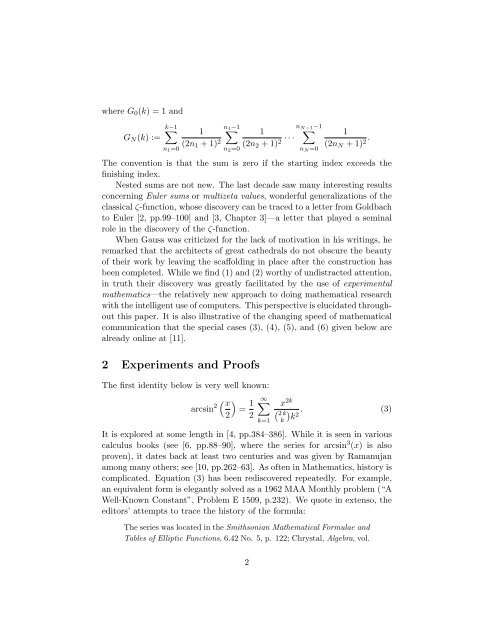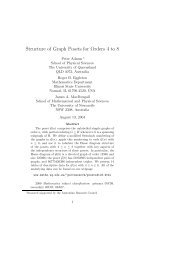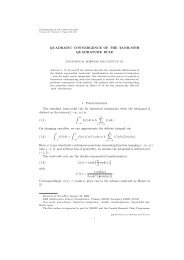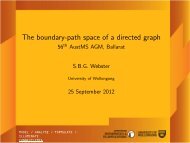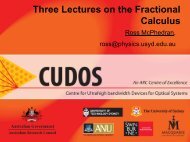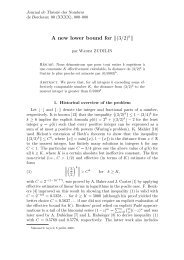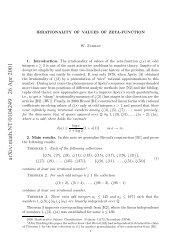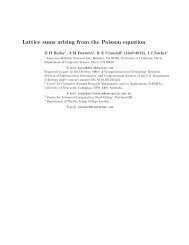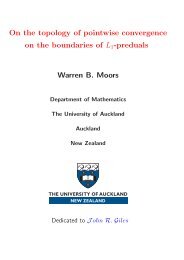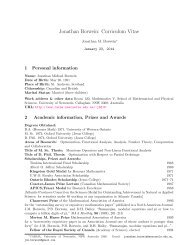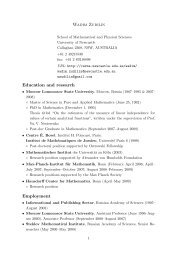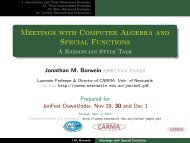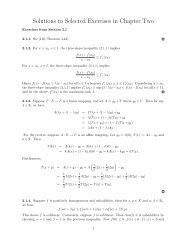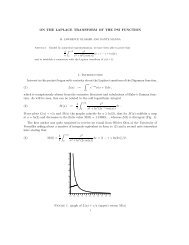Integer Powers of Arcsin - CiteSeerX
Integer Powers of Arcsin - CiteSeerX
Integer Powers of Arcsin - CiteSeerX
You also want an ePaper? Increase the reach of your titles
YUMPU automatically turns print PDFs into web optimized ePapers that Google loves.
where G 0 (k) = 1 and<br />
G N (k) :=<br />
∑k−1<br />
n 1 =0<br />
n<br />
1 ∑ 1 −1<br />
(2n 1 + 1) 2<br />
n 2 =0<br />
n N−1 −1<br />
1<br />
(2n 2 + 1) 2 · · · ∑<br />
n N =0<br />
1<br />
(2n N + 1) 2 .<br />
The convention is that the sum is zero if the starting index exceeds the<br />
finishing index.<br />
Nested sums are not new. The last decade saw many interesting results<br />
concerning Euler sums or multizeta values, wonderful generalizations <strong>of</strong> the<br />
classical ζ-function, whose discovery can be traced to a letter from Goldbach<br />
to Euler [2, pp.99–100] and [3, Chapter 3]—a letter that played a seminal<br />
role in the discovery <strong>of</strong> the ζ-function.<br />
When Gauss was criticized for the lack <strong>of</strong> motivation in his writings, he<br />
remarked that the architects <strong>of</strong> great cathedrals do not obscure the beauty<br />
<strong>of</strong> their work by leaving the scaffolding in place after the construction has<br />
been completed. While we find (1) and (2) worthy <strong>of</strong> undistracted attention,<br />
in truth their discovery was greatly facilitated by the use <strong>of</strong> experimental<br />
mathematics—the relatively new approach to doing mathematical research<br />
with the intelligent use <strong>of</strong> computers. This perspective is elucidated throughout<br />
this paper. It is also illustrative <strong>of</strong> the changing speed <strong>of</strong> mathematical<br />
communication that the special cases (3), (4), (5), and (6) given below are<br />
already online at [11].<br />
2 Experiments and Pro<strong>of</strong>s<br />
The first identity below is very well known:<br />
(<br />
arcsin 2 x<br />
)<br />
= 1 ∞∑<br />
2 2<br />
k=1<br />
x 2k<br />
( 2 k<br />
k<br />
)<br />
k 2 . (3)<br />
It is explored at some length in [4, pp.384–386]. While it is seen in various<br />
calculus books (see [6, pp.88–90], where the series for arcsin 3 (x) is also<br />
proven), it dates back at least two centuries and was given by Ramanujan<br />
among many others; see [10, pp.262–63]. As <strong>of</strong>ten in Mathematics, history is<br />
complicated. Equation (3) has been rediscovered repeatedly. For example,<br />
an equivalent form is elegantly solved as a 1962 MAA Monthly problem (“A<br />
Well-Known Constant”, Problem E 1509, p.232). We quote in extenso, the<br />
editors’ attempts to trace the history <strong>of</strong> the formula:<br />
The series was located in the Smithsonian Mathematical Formulae and<br />
Tables <strong>of</strong> Elliptic Functions, 6.42 No. 5, p. 122; Chrystal, Algebra, vol.<br />
2


